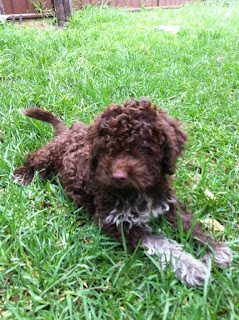These holidays we purchased a new puppy. His name is HUGO. This page will continue to track his adventures and growth.... Enjoy!
Pool Puppy 17.5 weeks old
 |
| A Water Dog Indeed, loving a swim in the Brisbane river! |
 |
| Hugo doing his reading eggs! |
Safe n Sound in the back of the car
Happy little rider - 17 weeks
A break at school after a long walk to get the girls
 |
| Lagotto Cooling System |
1st day at school
Hmm recreating the sorbent ad.... it did not break all the way down the stairs!
Proud Sorbent Man!
13 Weeks after a Clip
10 Weeks
 |
| Baby Boy |
 |
| Baby Hugo |
BREEDER
Hugo is a Lagotto Romagnolo... an Italian Water Dog.....
We purchased Hugo from breeders "duoforza" from Camden in NSW. They drove him to the airport where JetPets took him and flew him to Brisbane on Virgin for us.
We can't thank Sandi and Ray enough for entrusting us with their little bundle of joy!
HISTORY
A Brief history taken from the Australian Standard for the Lagotto Romagnolo....
Ancient breed of water retrieving dogs in the lowlands of Comacchio and the marshlands of Ravenna. Over the centuries, the great marshlands were drained and turned into arable land. Subsequently, the Lagotto Romagnolo changed from being a water dog to an excellent dog for searching for truffles in the flat open country and the hills of Romagna.
The Lagotto Romagnolo is probably one of the most ancient breeds of water dog known as well as being an absolutely natural breed. Archaeological excavations in the Etruscan burial ground of Spina [close to the Comacchio region] have found hunting and fishing etchings on clay and terra-cotta pots dating to the fifth and sixth centuries, showing a curly, shaggy-haired dog extremely similar to the present day Lagotto Romagnolo.
When water dogs arrived in Spain with the Moors, they had already been known through the whole Italian peninsula for centuries, but in particular in the wet and marshy areas of Northern Italy. The Barbet reached France after the Arab invasion of Spain and most scholars agree that the Barbet was the ancestor of the Poodle.
The ‘Canis Aquaticus’ [Water Dog] was mentioned by Linneus, the great Swedish naturalist of the eighteenth century, as having been ‘widespread for long’ in the Mediterranean area, and especially that of the North. Linneus’ description of the dog corresponds surprisingly with that of the curly haired dog of Romagna.
Eugenio Raimondi in his book ‘Delle Caccie’ [About Hunting](Venice, 1630), when discussing the water dogs that had always been popular in the Venetian lagoons wrote: ‘They do not fear to bring ducks to steep rocky places and being used to their noble duty, they do not fear to wet their backs and bottom, and bring their prey back to their master to please him. They are bristly and curly-haired dogs of the same colour as the reeds’.
Antonia Morri (Faenza 1840) in his ‘Household Technological Manual of Entries, Expressions, Proverbs, Popular Sayings and Idioms of Romagna’ described the ‘Can Lagott’ as a ‘thick-furred truffle or marsh dog’ or as ‘bristly-haired water or truffle dog’. This indicates that even then, the Lagotto Romagnolo was being transformed from a water dog to a truffle-hound.
There is unquestionable evidence that the Lagotto Romagnolo was present in the lagoons of Comacchio and the marshy areas of the lowland plains of Romagna as early as 1600. The inhabitants of the flat marshlands were known as ‘Lagotti’ and they used small dogs with very curly hair. They also went searching for truffles with their inseparable companion, the small Lagotto Romagnolo, who also guarded the boat and house and retrieved ducks. He would dive and swim for hours at a time even in very cold weather when he may have had to break the ice. This ‘amphibian’ behaviour was made possible by its truly waterproof thick coat, with very close curls and abundant undercoat preventing the water from touching the skin; it was sufficient just to shake itself and the dog was perfectly dry.
When the marshes were reclaimed the Lagotto Romagnolo progressively lost its function as a water dog and gradually specialised as a truffle-hound. His great ability to search, his keen sense of smell and trainability made him very suitable for the task.
Breeding in the early days was not controlled and had always been done to achieve practical results. Consequently, it tended to be between dogs closely related by blood. But in later years dogs were used that were not related, such as pointers, poodles,
etc. and this was not justified or in the interests of the breed. Therefore, in the late 1970’s, a group of distinguished dog fanciers from Romagna, decided it was time to save the breed. Over twenty years seminars and meetings took place, dogs were
examined, measured, tattooed and entered onto a Register with the result that the breed has evolved back again to a well defined, homogenous type.
The Italian Lagotto Romagnolo Club which now has over 400 members, was formed in 1988 and paved the way for official recognition of the breed. On the 15th October 1991 the Lagotto
Romagnolo became the thirteenth Italian dog breed and its numbers are estimated at between 3,000 to 3,500.
The Lagotto appeared in this painting by Guercino, from the Baroque period around 400 years ago.
(Source:Parity.Me)
Useful Lagotto Links
http://www.dogbreedinfo.com/lagottoromagnolo.htm
http://www.dogzonline.com.au/breeds/information/lagotto-romagnolo.asp
http://www.trufflesniffer.com/category/lagotto-information/










Have you an update on Hugo for us?
ReplyDelete